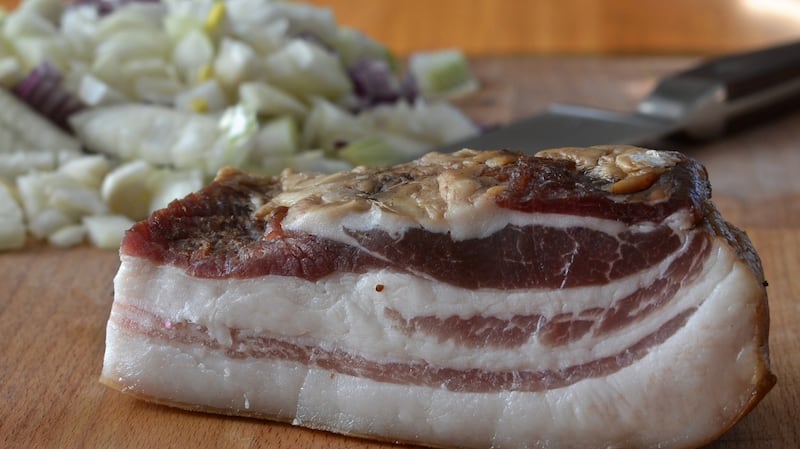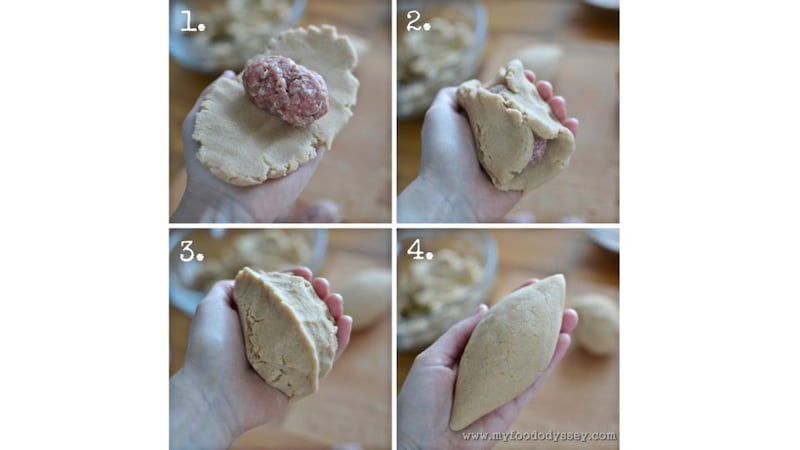The first time I made cepelinai, the Lithuanian national dish of dumplings made from potato, I failed miserably. And the second time. And probably the third time. After that, I called it quits and resolved only to eat cepelinai that had been prepared for me by someone who knew what they were doing - either at a restaurant or by one of our Lithuanian friends.
It’s not that cepelinai are particularly difficult to prepare, it’s just that the concepts were so foreign to me as an Irish person living here. I was told that they were made with grated potato, so I grated my potatoes the same way I would for hash browns. But that’s not what’s required. Although many recipes for cepelinai call for grated or even finely grated potato, what they actually mean is pulverized potato. If using a simple box grater you would use the zesting side, not the grating side.


The concept of making a potato dough using a combination of grated raw and cooked potato was also new to me. I thought we Irish ate a lot of potatoes, but our potato-eating habits pale by comparison with Lithuanians. Lithuanians have made potato-eating an art form, with a wide repertoire of dishes based around the humble spud.
Cepelinai (pronounced sep-elle-een-ay) are dumplings made with potato dough and a meat, cheese or vegetable filling. They have been prepared in Lithuania for over 150 years. Originally called "didžkukuliai" (which literally means "big meatballs"), they were re-christened cepelinai early in the 20th century due to their similarity in shape to the zeppelin airships.
Cepelinai are stodgy, hearty fodder designed to feed hungry workers at harvest time, or to provide sustenance and warmth during the harsh Lithuanian winters. Calorie-wise, they pack a real punch. A single 200g dumpling in my recipe contains 385g of potato. Two-thirds of the weight of the grated potato is lost when you squeeze out the water. Add to this the fatty mince and the even fattier pork belly, plus a nice dollop of sour cream, and you can see how the calorie-conscious might shy away from them.
Despite being the national dish, cepelinai are only prepared in Lithuanian homes on special occasions. They take quite a bit of time and are really only worth making in large batches. They are typically made as a treat for guests or, as mentioned, to feed hungry workers bringing potatoes or hay in from the fields.
Like all traditional dishes, every Lithuanian family has their own cepelinai recipe. This recipe I share here is designed for those who are new to making them, using a ratio of 60 per cent raw potato to 40 per cent cooked. This yields a dumpling that is sturdy enough to hold together during cooking but at the same time is soft and not too heavy to eat.
Cepelinai can come with a variety of sauces and toppings, but the most common is spirguciai (pronounced spear-goo-chay), made with fried onion and bacon belly, and a generous dollop of sour cream. Lithuanian sour cream is very rich, typically being 30-40 per cent fat. You could substitute crème fraîche, lower-fat sour cream or even Greek yoghurt if you prefer.
Lithuanian Cepelinai
Serves: 8 x 200g dumplings
Time: Prep: 2 hrs | Cook: 50 mins
INGREDIENTS:
For the potato dough:
3kg potatoes
2 tsp salt
Potato starch (available at Lithuanian, Polish or Eastern European food stores. However, if you can't find it, cornflour is the best substitute)
For the meat filling:
500g pork mince
1 tsp salt
½ tsp garlic powder
2 Tbsp cold water
For the spirguciai topping:
250g smoked bacon belly or pancetta, finely diced
400g onion (about 4-5 medium onions), finely chopped
To cook:
2 Tbsp potato starch or cornflour
100 ml cold water
To serve:
8 Tbsp sour cream / crème fraîche
METHOD:
1. Peel the potatoes, placing them into a bowl of cold water to ensure they do not turn brown.
2. Take 500g of potato, cut into quarters and place in a saucepan. Cover with boiling water and bring to the boil, then reduce the heat to low, cover with a lid and simmer for 8-12 minutes until the tip of a knife can easily be inserted into the potato pieces. Drain and set aside, uncovered, to cool.
3. While the potatoes are boiling, grate or purée the remaining raw potato. If you don’t own a potato grating machine, use either the zesting side of a box grater or purée the potatoes to a very fine pulp in a food processor (process the potatoes in two batches to ensure no small lumps are left in the purée).
4. Pour the purée into a large piece of butter muslin or cheesecloth (I use a cotton pillowcase) set over a large bowl. Gather the corners of the material and twist to squeeze out all water from the potatoes. This can take 5-10 minutes depending on the variety of potato and the strength of your hands.
5. Carefully transfer the dry grated potato to a large bowl. Keep the liquid that came out of the potatoes - you may need this later
6. Using a potato ricer or masher, mash the cooked potatoes until no lumps remain. Do not add any liquids or fats to the potato as you might if you were making mashed potato. Add the mashed potato to the grated raw potato.
7. Add salt and mix well with your hands.
8. The dough should be the consistency of play dough - it should form a smooth ball easily but should not stick to your hands. The consistency is key to the success of your final cepelinai. If it is too wet it will stick to your hands as you form your dumplings. If it is too dry it will crack and the dumplings may split or fall apart during cooking. If your mix is too dry, add a little of the liquid from the grated potatoes, a tablespoon at a time, until it reaches the required consistency. If the mixture is too wet, add some potato starch or cornflour.
9. In a separate bowl, add the pork mince, salt, garlic powder and water. Mix thoroughly using your hands.
10. Divide both the potato dough and meat mixture into 8 equal portions and lay out on a plate or worktop. Form the meat into tight balls the shape of a rugby ball.
11. You are now ready to form your cepelinai. Take a portion of dough and flatten it against the palm of your hand until it is roughly the shape of your hand and just under 1 cm thick, turning regularly as you shape the dough to ensure it does not stick to your hands.
12. Place a piece of meat on the centre of the dough, fold the sides over the top of the meat and pinch together firmly to seal the join. Firmly press the dumpling between your two palms, rotating the dumpling little by little, to form the classic zeppelin shape.
13. Ensure there are no cracks on the surface of the dumpling. If you find any, dip your fingertip into the juice from the grated potatoes and gently smooth over to seal them.
14. Continue with the remaining ingredients until you have assembled all your cepelinai.
15. Half-fill a 7 litre / 7 quart saucepan, Dutch oven or other large saucepan with cold water and set over a high heat. When the water is boiling, mix 2 tablespoons of potato starch or cornflour with a cup of cold water and add to the saucepan, stirring well as you add the starch liquid to ensure it does not form a gelatinous ball. Adding starch to the cooking water helps to prevent the dumplings from splitting during cooking. It also helps to give the dumplings a smooth, glossy finish.
16. Carefully add the dumplings to the saucepan. They will initially sink to the bottom, but will later float to the surface. Cover with a lid, bring the water back to the boil, then reduce the heat to very low so that the water is barely simmering - if the water is boiling too hard the dumplings might split. Simmer for 45 minutes.
17. While the cepelinai are cooking make the spirguciai. Add the bacon pieces to a frying pan or saucepan and set over a high heat. There is no need to add oil as the fat will render from the bacon. When the bacon pieces are golden and starting to crisp, add the onion and reduce the heat to medium. Cook, stirring frequently, until the onions are soft and just starting to turn brown.
18. To serve, carefully lift the cepelinai from the saucepan using a slotted spoon and place on a bowl or plate. Top with a spoon of spirgu?iai and a dollop of sour cream.
This article first appeared on June's blog myfoododyssey.com, winner of Best Blog by the Diaspora at Blog Awards Ireland in October.















